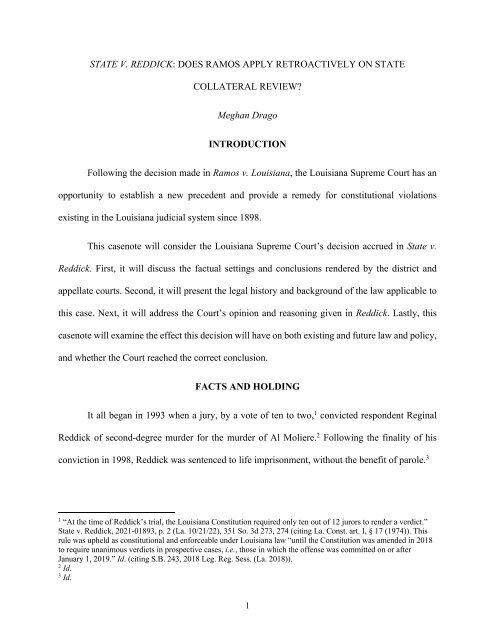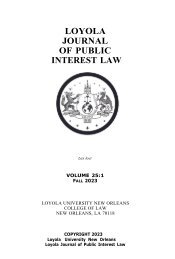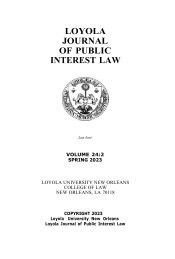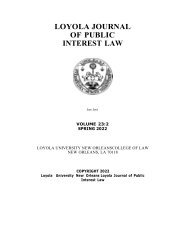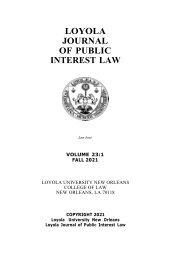STATE V. REDDICK: Does Ramos Apply Retroactively on State Collateral Review?
You also want an ePaper? Increase the reach of your titles
YUMPU automatically turns print PDFs into web optimized ePapers that Google loves.
<str<strong>on</strong>g>STATE</str<strong>on</strong>g> V. <str<strong>on</strong>g>REDDICK</str<strong>on</strong>g>: DOES RAMOS APPLY RETROACTIVELY ON <str<strong>on</strong>g>STATE</str<strong>on</strong>g><br />
COLLATERAL REVIEW?<br />
Meghan Drago<br />
INTRODUCTION<br />
Following the decisi<strong>on</strong> made in <str<strong>on</strong>g>Ramos</str<strong>on</strong>g> v. Louisiana, the Louisiana Supreme Court has an<br />
opportunity to establish a new precedent and provide a remedy for c<strong>on</strong>stituti<strong>on</strong>al violati<strong>on</strong>s<br />
existing in the Louisiana judicial system since 1898.<br />
This casenote will c<strong>on</strong>sider the Louisiana Supreme Court’s decisi<strong>on</strong> accrued in <strong>State</strong> v.<br />
Reddick. First, it will discuss the factual settings and c<strong>on</strong>clusi<strong>on</strong>s rendered by the district and<br />
appellate courts. Sec<strong>on</strong>d, it will present the legal history and background of the law applicable to<br />
this case. Next, it will address the Court’s opini<strong>on</strong> and reas<strong>on</strong>ing given in Reddick. Lastly, this<br />
casenote will examine the effect this decisi<strong>on</strong> will have <strong>on</strong> both existing and future law and policy,<br />
and whether the Court reached the correct c<strong>on</strong>clusi<strong>on</strong>.<br />
FACTS AND HOLDING<br />
It all began in 1993 when a jury, by a vote of ten to two, 1 c<strong>on</strong>victed resp<strong>on</strong>dent Reginal<br />
Reddick of sec<strong>on</strong>d-degree murder for the murder of Al Moliere. 2 Following the finality of his<br />
c<strong>on</strong>victi<strong>on</strong> in 1998, Reddick was sentenced to life impris<strong>on</strong>ment, without the benefit of parole. 3<br />
1<br />
“At the time of Reddick’s trial, the Louisiana C<strong>on</strong>stituti<strong>on</strong> required <strong>on</strong>ly ten out of 12 jurors to render a verdict.”<br />
<strong>State</strong> v. Reddick, 2021-01893, p. 2 (La. 10/21/22), 351 So. 3d 273, 274 (citing La. C<strong>on</strong>st. art. I, § 17 (1974)). This<br />
rule was upheld as c<strong>on</strong>stituti<strong>on</strong>al and enforceable under Louisiana law “until the C<strong>on</strong>stituti<strong>on</strong> was amended in 2018<br />
to require unanimous verdicts in prospective cases, i.e., those in which the offense was committed <strong>on</strong> or after<br />
January 1, 2019.” Id. (citing S.B. 243, 2018 Leg. Reg. Sess. (La. 2018)).<br />
2<br />
Id.<br />
3<br />
Id.<br />
1
At the time the Supreme Court decided <str<strong>on</strong>g>Ramos</str<strong>on</strong>g>, 4 Reddick’s c<strong>on</strong>victi<strong>on</strong> and sentence were<br />
already made final. 5 Therefore, <strong>on</strong> March 30, 2021, he filed an applicati<strong>on</strong> for post-c<strong>on</strong>victi<strong>on</strong><br />
relief, requesting retroactive applicati<strong>on</strong> of the <str<strong>on</strong>g>Ramos</str<strong>on</strong>g> rule to his c<strong>on</strong>victi<strong>on</strong>. Following the<br />
Supreme Court’s decisi<strong>on</strong> established in Edwards v. Vannoy, 6 the District Court granted Reddick’s<br />
applicati<strong>on</strong> for post-c<strong>on</strong>victi<strong>on</strong> relief, finding that <str<strong>on</strong>g>Ramos</str<strong>on</strong>g> applied retroactively. 7 The Louisiana<br />
Fourth Circuit Court of Appeals declined to review the decisi<strong>on</strong>. 8 Following the Fourth Circuit’s<br />
refusal, the <strong>State</strong> filed a writ applicati<strong>on</strong> with the Louisiana Supreme Court requesting review of<br />
the lower court’s prior decisi<strong>on</strong>s. 9 The Court granted the writ to “resolve a circuit split as to<br />
whether the new rule announced by the Supreme Court in <str<strong>on</strong>g>Ramos</str<strong>on</strong>g> v. Louisiana . . . applies<br />
retroactively to cases <strong>on</strong> state collateral review.” 10 In result, the Court held that jury-unanimity<br />
rule from <str<strong>on</strong>g>Ramos</str<strong>on</strong>g> does not apply retroactively in Louisiana <strong>on</strong> state collateral review. 11<br />
BACKGROUND<br />
This secti<strong>on</strong> of the casenote will address the background of the law relevant to this case.<br />
First, it addresses the retroactive applicati<strong>on</strong> of new criminal rules. Then, it will address the<br />
c<strong>on</strong>stituti<strong>on</strong>al jurisprudence surrounding the interpretati<strong>on</strong> of the Sixth Amendment right to an<br />
impartial jury.<br />
4<br />
“In <str<strong>on</strong>g>Ramos</str<strong>on</strong>g> v. Louisiana, 590 U.S. ----, 140 S.Ct. 1390, 206 L.Ed.2d 583 (2020), the United <strong>State</strong> Supreme Court<br />
overturned Apocada [v. Oreg<strong>on</strong>, 406 U.S. 404 (1972)] and held that the Sixth Amendment right to a jury trial, as<br />
incorporated against the states by the Fourteenth Amendment, requires a unanimous verdict to c<strong>on</strong>vict a defendant<br />
of a serious offense and this requirement applies equally to state and federal criminal trials.” Id. at 2-3, 351 So. 3d at<br />
274-75 (citing <str<strong>on</strong>g>Ramos</str<strong>on</strong>g>, 140 S. Ct. 1390 at 1395-96) (footnote omitted).<br />
5<br />
Id. at 3, 351 So. 3d at 275.<br />
6<br />
“[I]n Edwards v. Vannoy, 593 U.S. ----, 141 S.Ct. 1547, 209 L.Ed.2d 651 (2021), the Supreme Court declined to<br />
apply the new rule announced in <str<strong>on</strong>g>Ramos</str<strong>on</strong>g> retroactively to final c<strong>on</strong>victi<strong>on</strong> <strong>on</strong> federal habeas review.” Id.<br />
7<br />
Id.<br />
8<br />
Id. (citati<strong>on</strong> omitted).<br />
9<br />
Id.<br />
10<br />
Id. at 1, 351 So. 3d at 274.<br />
11<br />
Id.<br />
2
A. Retroactivity of New Criminal Rules<br />
Retroactivity jurisprudence is “c<strong>on</strong>cerned, not with the questi<strong>on</strong> whether a c<strong>on</strong>stituti<strong>on</strong>al<br />
violati<strong>on</strong> occurred, but with the availability or n<strong>on</strong>availability of remedies.” 12 Meaning,<br />
retroactivity is not based <strong>on</strong> whether a c<strong>on</strong>stituti<strong>on</strong>al violati<strong>on</strong> occurred. 13 For example, the<br />
Supreme Court in <str<strong>on</strong>g>Ramos</str<strong>on</strong>g> held “that all n<strong>on</strong>unanimous guilty verdicts violated the Sixth<br />
Amendment.” 14 Therefore, the retroactivity questi<strong>on</strong> became “whether that violati<strong>on</strong> will be<br />
remedied in cases where the c<strong>on</strong>victi<strong>on</strong> was final when the case announcing the newly-recognized<br />
right was decided.” 15<br />
In Teague v. Lane, the Supreme Court established a new retroactivity analysis for cases <strong>on</strong><br />
federal habeas review, which focuses <strong>on</strong> c<strong>on</strong>cerns for federalism, comity, and finality. 16 The first<br />
step of the inquiry requires distinguishing between old and new rules. 17 In other words, the court<br />
must determine which date the c<strong>on</strong>victi<strong>on</strong> became final because new criminal rules exclusively<br />
apply to all cases <strong>on</strong> direct review but not those case established as final. 18 After classifying the<br />
rule as new, the court must determine whether the rule falls within <strong>on</strong>e of the two excepti<strong>on</strong>s<br />
articulated by the Supreme Court: (i) a substantive “rule prohibiting a certain category of<br />
punishment for a class of defendants because of their status or offense,” and (ii) “watershed rules<br />
of criminal procedure implicating the fundamental fairness and accuracy of the criminal<br />
proceeding.” 19 “In 1992, Louisiana adopted the Supreme Court’s multi-step framework established<br />
12<br />
Danforth v. Minnesota, 552 U.S. 264, 290-91 (2008).<br />
13<br />
Id.<br />
14<br />
Reddick, 2021-01893 at 4, 351 So. 3d at 275.<br />
15<br />
Id.<br />
16<br />
Teague v. Lane, 489 U.S. 288 (1989); see Withrown v. Williams, 507 U.S. 680, 699 (1993) (O’C<strong>on</strong>nor, J.,<br />
c<strong>on</strong>curring in part and dissenting in part) (discussing the “prudential c<strong>on</strong>cerns” or “equity and federalism”<br />
articulated in Teague).<br />
17<br />
See Teague, 489 U.S. at 310.<br />
18<br />
Id.<br />
19<br />
Saffle v. Parks, 494 U.S. 484, 494-95 (1990) (citati<strong>on</strong>s and internal quotes omitted).<br />
3
in Teague to determine whether new rules of c<strong>on</strong>stituti<strong>on</strong>al criminal law will be applied<br />
retroactively to cases <strong>on</strong> both state and federal collateral review. 20<br />
The Court in Danforth v. Minnesota further elaborated <strong>on</strong> the Teague decisi<strong>on</strong>. 21 In doing so,<br />
the Court held that states could give greater retroactive effect to new rules in the state postc<strong>on</strong>victi<strong>on</strong><br />
c<strong>on</strong>text than the Supreme Court affords in the federal habeas c<strong>on</strong>text. 22 Furthermore,<br />
the c<strong>on</strong>cerns of comity and federalism that carried greater weight in the Teague analysis are not<br />
present during state collateral review. 23 Thus, the federal interest in uniformity does not outweigh<br />
the <strong>State</strong>s’ authority, as independent sovereigns, to make and enforce their own laws so l<strong>on</strong>g as<br />
they do not violate federal c<strong>on</strong>stituti<strong>on</strong>al guarantees. 24<br />
Similarly, in Edwards, the Supreme Court held that <str<strong>on</strong>g>Ramos</str<strong>on</strong>g>’ unanimity rule should not apply<br />
retroactively because it was not a watershed rule of criminal procedure falling within Teague’s<br />
sec<strong>on</strong>d excepti<strong>on</strong>. 25 However, the Court did not stop its analysis there. 26 Additi<strong>on</strong>ally, the Court<br />
found, since adopting the new retroactivity framework established in Teague, that it failed to<br />
identify any rule that fell within the watershed excepti<strong>on</strong>. 27 Thus, no new criminal procedural rule<br />
had applied retroactively. 28 The Court reached a very narrow c<strong>on</strong>clusi<strong>on</strong> and held that there is no<br />
possibility that any new procedural rule would ever apply retroactively <strong>on</strong> federal habeas review. 29<br />
20<br />
Reddick, 2021-01893 at 5, 351 So. 3d at 276 (citing <strong>State</strong> ex rel. Taylor v. Whitely, 606 So. 2d 1292, 1297 (La.<br />
1992) (“noting that the c<strong>on</strong>siderati<strong>on</strong>s of finality recognized in Teague are ‘equally applicable in state proceedings<br />
as well as federal proceedings’”)).<br />
21<br />
Danforth v. Minnesota, 552 U.S. 264, 282 (2008).<br />
22<br />
Id. at 289 (citati<strong>on</strong> omitted).<br />
23<br />
Id. at 279-80.<br />
24<br />
Id. at 280.<br />
25<br />
Edwards v. Vannoy, 141 S. Ct. 1547, 1559 (2021).<br />
26<br />
Id.<br />
27<br />
Id.<br />
28<br />
Id.<br />
29<br />
Id.<br />
4
Therefore, the Louisiana Supreme Court is required to apply “all new rules to cases <strong>on</strong> direct<br />
review . . . and must apply all new substantive rules to cases <strong>on</strong> collateral review.” 30 Thus, “the<br />
<strong>on</strong>ly choice left for the states is whether to apply new rules of criminal procedure to cases <strong>on</strong> state<br />
collateral review.” 31<br />
B. Sixth Amendment Right to C<strong>on</strong>victi<strong>on</strong> by a Unanimous Jury<br />
In the early years of Louisiana history, the Louisiana Supreme Court endorsed n<strong>on</strong>unanimous<br />
verdicts for serious crimes. 32 It began in 1898, when Louisiana first endorsed n<strong>on</strong>unanimous<br />
verdicts for serious crimes at a c<strong>on</strong>stituti<strong>on</strong>al c<strong>on</strong>venti<strong>on</strong>. 33 “According to <strong>on</strong>e committee<br />
chairman, the avowed purpose of that c<strong>on</strong>venti<strong>on</strong> was to ‘establish the supremacy of the white<br />
race,’ and the resulting document included many of the trappings of the Jim Crow era: a poll tax,<br />
a combined literacy and property ownership test, and a grandfather clause that in practice exempted<br />
white residents from the most <strong>on</strong>erous of these requirements.” 34 However, the delegates were not<br />
<strong>on</strong>ly c<strong>on</strong>cerned with the prospect of African American voting. 35 A few days before the c<strong>on</strong>venti<strong>on</strong>,<br />
the U.S. Senate introduced an investigati<strong>on</strong> into “whether Louisiana was systematically excluding<br />
African-Americans from juries.” 36 As an attempt to avert nati<strong>on</strong>al attenti<strong>on</strong> and to avoid the<br />
likelihood of the Court striking down “any policy of overt discriminati<strong>on</strong> against African-<br />
American . . . juror[s] as a violati<strong>on</strong> of the Fourteenth Amendment,” the delegates sabotaged<br />
“African-American participati<strong>on</strong> <strong>on</strong> juries in another way.” 37 In result, “the c<strong>on</strong>venti<strong>on</strong> delegates<br />
30<br />
<strong>State</strong> v. Reddick, 2021-01893, p. 7 (La. 10/21/22), 351 So.3d 273, 277.<br />
31<br />
Id.<br />
32<br />
<str<strong>on</strong>g>Ramos</str<strong>on</strong>g> v. Louisiana, 140 S. Ct. 1390, 1394 (2020).<br />
33<br />
Id.<br />
34<br />
Id. (citati<strong>on</strong> omitted)._<br />
35<br />
Id.<br />
36<br />
Id. (citati<strong>on</strong> omitted).<br />
37<br />
Id.<br />
5
sculpted a ‘facially race-neutral’ rule permitting 10-to-2 verdicts in order ‘to ensure that African-<br />
American juror service would be meaningless.’” 38<br />
The Louisiana Supreme Court has repeatedly recognized that the Sixth Amendment requires<br />
unanimity. 39 But does such requirement of unanimity apply to both “state and federal criminal<br />
trials equally?” 40 In 1972, the Court attacked this unc<strong>on</strong>venti<strong>on</strong>al scheme for the first time in<br />
Apodaca v. Oreg<strong>on</strong> 41 and Johns<strong>on</strong> v. Louisiana 42 (together “Apodaca”). In determining whether<br />
unanimity serves an essential functi<strong>on</strong> of society, the four-Justice plurality in Apocada “c<strong>on</strong>cluded<br />
that unanimity’s costs outweighed its benefits.” 43 Thus, it upheld the c<strong>on</strong>stituti<strong>on</strong>ality of<br />
n<strong>on</strong>unanimous verdicts. 44 Similarly, in Johns<strong>on</strong>, the Court held that n<strong>on</strong>unanimous jury verdict<br />
satisfied the state’s burden of proving guilt bey<strong>on</strong>d a reas<strong>on</strong>able doubt. 45 Although majority of the<br />
justices in these two opini<strong>on</strong>s recognized that the Sixth Amendment required unanimity, the<br />
Supreme Court c<strong>on</strong>tinued allowing n<strong>on</strong>unanimous verdicts in state trials; as a result, Louisiana<br />
c<strong>on</strong>tinued to enforce its n<strong>on</strong>unanimous verdict system. 46<br />
It was not until several years later, in 2020, that <str<strong>on</strong>g>Ramos</str<strong>on</strong>g> overturned Apocada. 47 The <str<strong>on</strong>g>Ramos</str<strong>on</strong>g><br />
Court “explained the history of the Sixth Amendment guarantee of unanimity, and noted that it<br />
applies equally to the states and federal system, promotes the fundamental noti<strong>on</strong> of a fair and<br />
reliable verdict, and is ‘fundamental to the American scheme of justice.’” 48<br />
38<br />
Id.<br />
39<br />
Id. at 1397.<br />
40<br />
Id.<br />
41<br />
Apodaca v. Oreg<strong>on</strong>, 406 U.S. 404 (1972).<br />
42<br />
Johns<strong>on</strong> v. Louisiana, 406 U.S. 356 (1972).<br />
43<br />
<str<strong>on</strong>g>Ramos</str<strong>on</strong>g>, 140 S. Ct. at 1394.<br />
44<br />
Id.<br />
45<br />
Johns<strong>on</strong>, 406 U.S. at 362.<br />
46<br />
<strong>State</strong> v. Reddick, 2021-01893, p. 8 (La. 10/21/22), 351 So.3d 273, 278.<br />
47<br />
Id. 9, 351 So. 3d at 279.<br />
48<br />
Id.<br />
6
THE COURT’S OPINION AND REASONING<br />
Justice Cricht<strong>on</strong> delivered the opini<strong>on</strong> of the Court, which granted the <strong>State</strong>’s writ<br />
applicati<strong>on</strong> to resolve a circuit split as to whether the new rule established by the Supreme Court<br />
in <str<strong>on</strong>g>Ramos</str<strong>on</strong>g>, requiring a unanimous jury for criminal c<strong>on</strong>victi<strong>on</strong>s, applies retroactively to cases <strong>on</strong><br />
state collateral review. 49 The Court, applying the framework founded in Teague, “but using the<br />
authority expressly reserved to the states by the Supreme Court to determine which new rules of<br />
criminal procedure will be applied retroactively <strong>on</strong> state collateral review, [found] that the <str<strong>on</strong>g>Ramos</str<strong>on</strong>g><br />
jury unanimity rule does not apply retroactively in Louisiana.” 50 The Court begins by<br />
acknowledging “the str<strong>on</strong>g reliance interests at stake and the high administrative burden that many<br />
retrials would impose <strong>on</strong> [the Louisiana judicial] system.” 51 Further, citizens of the state voting to<br />
amend the Louisiana C<strong>on</strong>stituti<strong>on</strong> to require unanimous jury verdicts, “d[id] so with prospective<br />
effect <strong>on</strong>ly.” 52 Thus, this “decisi<strong>on</strong> of the people should not be disturbed by the judiciary, whose<br />
role . . . [is] not to announce policy more rightfully reserved to the legislature.” 53<br />
The Court relies <strong>on</strong> the Supreme Court’s decisi<strong>on</strong> in Edwards, which adhered to the Court’s<br />
c<strong>on</strong>clusi<strong>on</strong> that the rule announced in <str<strong>on</strong>g>Ramos</str<strong>on</strong>g> was not watershed and therefore, did not warrant<br />
retroactive applicati<strong>on</strong>. 54 Critical to the Court’s analysis is this Court’s precedent which<br />
emphasized that “‘[n]ew procedural rules do not apply retroactively <strong>on</strong> federal collateral<br />
review.”’ 55 The <str<strong>on</strong>g>Ramos</str<strong>on</strong>g> rule is “momentous and c<strong>on</strong>sequential” just like previous Supreme Court<br />
decisi<strong>on</strong>s that did not apply retroactively <strong>on</strong> federal collateral review, but this Court lacks any<br />
49<br />
Id. at 274.<br />
50<br />
Id.<br />
51<br />
Id.<br />
52<br />
Id. at 1-2.<br />
53<br />
Id. at 2.<br />
54<br />
Id. at 11, 351 So. 3d at 280.<br />
55<br />
Id.<br />
7
“good rati<strong>on</strong>ale for treating <str<strong>on</strong>g>Ramos</str<strong>on</strong>g> differently.” 56 Thus, the district court erred in deeming <str<strong>on</strong>g>Ramos</str<strong>on</strong>g><br />
retroactive. 57<br />
Similarly, the Court rejected the resp<strong>on</strong>dent’s suggesti<strong>on</strong> that the Court find that Louisiana<br />
has a broader interpretati<strong>on</strong> of watershed under Teague than that of the Supreme Court, while<br />
heavily relying <strong>on</strong> the court’s previous criminal procedure applicati<strong>on</strong>. 58 “[E]very time the<br />
Supreme Court has examined whether a rule of criminal procedure is retroactive, it found it was<br />
not” and Louisiana courts have c<strong>on</strong>sistently upheld those holdings. 59 Thus, the Court is “not<br />
persuaded that a departure from such precedent is warranted here.” 60<br />
Even though the Court declined to uphold the resp<strong>on</strong>dent’s watershed analysis, it also<br />
rejected the state’s proposal that it find “no rule of criminal procedure can ever be retroactive in<br />
Louisiana.” 61 Critical to the Court’s reas<strong>on</strong>ing is its “authority under Danforth to retain the entirety<br />
of the Teague approach, as adopted in Taylor, with <strong>on</strong>e excepti<strong>on</strong>: replacing the “moribund”<br />
watershed excepti<strong>on</strong> for new rules of criminal procedure with a c<strong>on</strong>siderati<strong>on</strong> of factors that more<br />
comprehensively take into account the totality of c<strong>on</strong>cerns that inform retroactivity.” 62<br />
Focusing more <strong>on</strong> the factors that c<strong>on</strong>sider the totality of c<strong>on</strong>cerns that inform retroactivity,<br />
the Court found that such c<strong>on</strong>cerns outweigh retroactive applicati<strong>on</strong> of the <str<strong>on</strong>g>Ramos</str<strong>on</strong>g> rule. 63 First, in<br />
determining the purpose to be served by the new rule, the Court c<strong>on</strong>cluded that <str<strong>on</strong>g>Ramos</str<strong>on</strong>g> greatly<br />
emphasized the enormity of the right at stake, deeming jury unanimity to be ‘“fundamental to the<br />
56<br />
Id. at 11 (quoting Edwards v. Vannoy, 141 S. Ct. 1547, 1559 (2021)).<br />
57<br />
Id. at 12, 351 So. 3d at 281.<br />
58<br />
Id.<br />
59<br />
Id.<br />
60<br />
Id.<br />
61<br />
Id.<br />
62<br />
Id. at 12-13.<br />
63<br />
Id. at 16, 351 So.3d at 283.<br />
8
American scheme of justice.”’ 64 Louisiana voters and the state legislature remedied the wr<strong>on</strong>g<br />
before the Supreme Court rules in <str<strong>on</strong>g>Ramos</str<strong>on</strong>g> in April 2020, however, <strong>on</strong>ly prospectively. 65 Sec<strong>on</strong>d,<br />
after establishing the purpose of the new rule, the majority proceeds to c<strong>on</strong>sider the<br />
“reas<strong>on</strong>ableness of reliance up<strong>on</strong> the old rule of criminal procedure and the durati<strong>on</strong> of such<br />
reliance.” 66 Despite the negative criticism of the Apocada decisi<strong>on</strong> exemplified throughout the<br />
<str<strong>on</strong>g>Ramos</str<strong>on</strong>g> decisi<strong>on</strong>, it remained the Louisiana law relied up<strong>on</strong> until it was overruled by <str<strong>on</strong>g>Ramos</str<strong>on</strong>g> several<br />
years later. 67 In other words, Apocada obtained enormous reliance by the judicial system of<br />
Louisiana. 68 Thus, the Court found that the “thousands of cases tried during the nearly 50 years of<br />
the state’s reas<strong>on</strong>able reliance <strong>on</strong> Supreme Court precedent upholding this procedure weighs<br />
heavily against retroactive applicati<strong>on</strong> of the <str<strong>on</strong>g>Ramos</str<strong>on</strong>g> rule.” 69 Lastly, while focusing up<strong>on</strong> the effect<br />
<strong>on</strong> the administrati<strong>on</strong> of justice of a retroactive applicati<strong>on</strong> of a new rule, the Court found that<br />
applying <str<strong>on</strong>g>Ramos</str<strong>on</strong>g> retroactively to hundreds of cases involving individuals who were incarcerated<br />
based <strong>on</strong> n<strong>on</strong>unanimous verdicts would pose practical problems that could impede the promoti<strong>on</strong><br />
of justice. 70 The majority reas<strong>on</strong>s that these extensive administrati<strong>on</strong> of justice c<strong>on</strong>cerns weigh<br />
substantially against any benefit of retroactivity. 71 Thus, the Supreme Court ruled in favor of the<br />
state and found the new rule of criminal procedure announced in <str<strong>on</strong>g>Ramos</str<strong>on</strong>g> requiring unanimity in<br />
jury verdicts is not retroactive <strong>on</strong> state collateral review in Louisiana. 72<br />
64<br />
<str<strong>on</strong>g>Ramos</str<strong>on</strong>g> v. Louisiana, 140 S. Ct. 1390, 1395-97. (“There can be no questi<strong>on</strong> that the Sixth Amendment’s unanimity<br />
requirement applies to state and federal criminal trials equally.”).<br />
65<br />
Reddick, 2021-01893 at 14, 351 So.3d at 281 n.9.<br />
66<br />
Id.<br />
67<br />
Id. at 15, 351 So. 3d at 282.<br />
68<br />
Id.<br />
69<br />
Id.<br />
70<br />
Id. at 15, 351 So. 3d at 283.<br />
71<br />
Id. at 16.<br />
72<br />
Id.<br />
9
An alternative view is well-established in Justice Genovese’s opini<strong>on</strong>. 73 He c<strong>on</strong>cludes that<br />
<str<strong>on</strong>g>Ramos</str<strong>on</strong>g> was not a watershed rule and generally c<strong>on</strong>curs with the majority that the <str<strong>on</strong>g>Ramos</str<strong>on</strong>g> “jury<br />
unanimity rule does not apply retroactively to cases <strong>on</strong> [state level] collateral review.” 74 Differing<br />
from the majority view, Justice Genovese believes that “<strong>on</strong>ly those defendants who were c<strong>on</strong>victed<br />
by n<strong>on</strong>-unanimous verdicts due to racial animus are entitled to relief <strong>on</strong> collateral review.” 75<br />
Therefore, a “n<strong>on</strong>-unanimous jury verdict without racial animus would not qualify for relief <strong>on</strong><br />
collateral review.” 76 In his view, such racial animus is present “when the jury vote of an African<br />
American is disenfranchised and discounted, which occurs when a jury can reach a verdict without<br />
said African American vote under the prior n<strong>on</strong>unanimous verdict rule of law.” 77 Thus, Justice<br />
Genovese finds that the lower courts decisi<strong>on</strong>s should be reversed, regardless of the date of<br />
c<strong>on</strong>victi<strong>on</strong>, <strong>on</strong>ly if there is proof <strong>on</strong> collateral review by the defendant by a prep<strong>on</strong>derance of the<br />
evidence showing racial animus resulting in alleged n<strong>on</strong>-unanimous verdict. 78 However, in this<br />
case, since the defendant failed to do so, the lower courts must be reversed. 79<br />
In Justice Griffin’s thorough dissent, she finds that the <str<strong>on</strong>g>Ramos</str<strong>on</strong>g> rule falls within the<br />
watershed excepti<strong>on</strong> and should be applied retroactively <strong>on</strong> state collateral review. 80 The dissent<br />
refuses to accept the majority’s adopti<strong>on</strong> of a Teague/Linkletter hybrid test and its denial of<br />
retroactive relief to those c<strong>on</strong>victed by n<strong>on</strong>-unanimous jury verdicts. 81 Instead of the majority’s<br />
adopti<strong>on</strong> of a Teague/Linkletter hybrid test, the dissent favors use of a holistic approach to the<br />
73<br />
Id. at 15, 351 So. 3d at 286 (Genovese, J., c<strong>on</strong>curring in part and dissenting in part).<br />
74<br />
Id. 351 So. 3d at 287.<br />
75<br />
Id. at 2.<br />
76<br />
Id.<br />
77<br />
Id.<br />
78<br />
Id.<br />
79<br />
Id.<br />
80<br />
Id. at 292 (Griffin, J., dissenting).<br />
81<br />
Id.<br />
10
Teague watershed test, finding that <str<strong>on</strong>g>Ramos</str<strong>on</strong>g> applies retroactively. 82 The dissent reas<strong>on</strong>ed that such<br />
approach is “c<strong>on</strong>sistent with this Court’s treatment of Gide<strong>on</strong> v. Wainwright, as being the type of<br />
case that presents a watershed rule.” 83 Hence, if the watershed inquiry relies solely <strong>on</strong> the analysis<br />
of specific elements in a particular case, then even Gide<strong>on</strong> would fail such test. 84 Instead of the<br />
majority’s analysis, the dissent provides that a case being judged holistically will meet all<br />
watershed requirements and be applied retroactively if these four interrelated elements are met:<br />
(1) it prevents an actual or generally understood impermissibly large risk of<br />
err<strong>on</strong>eous c<strong>on</strong>victi<strong>on</strong>s; (2) it can be said to be in the same category as Gide<strong>on</strong> in<br />
having effected a profound and sweeping change in the law; (3) it is not narrowly<br />
applicable to <strong>on</strong>ly a small subset of defendants; and (4) it can be said to touch <strong>on</strong><br />
fundamental aspects of our understanding of the basic procedural elements of<br />
essential fundamental fairness. 85<br />
In applying these four factors, the dissent argues that <str<strong>on</strong>g>Ramos</str<strong>on</strong>g> meets all four requirements<br />
for a number of reas<strong>on</strong>s and therefore, falls within the watershed excepti<strong>on</strong>. 86 First, the dissent<br />
reas<strong>on</strong>s that unanimous juries prevent err<strong>on</strong>eous c<strong>on</strong>victi<strong>on</strong> and notably, are more thorough in their<br />
c<strong>on</strong>siderati<strong>on</strong> of evidence. 87 Next, the dissent argues that <str<strong>on</strong>g>Ramos</str<strong>on</strong>g> is a “profound sweeping change<br />
in the law which touches <strong>on</strong> basic fundamental fairness” that every citizen of Louisiana is entitled<br />
to. 88 The decisi<strong>on</strong> rectified a regulati<strong>on</strong> that had been established with the discriminatory aim of<br />
curtailing the influence of Black jurors. 89 One delegate from the 1973 C<strong>on</strong>venti<strong>on</strong> recognized that<br />
the judicial system discriminated against minority groups references as being ‘“ugly, poor, [and]<br />
illiterate,’ but that juries ‘d<strong>on</strong>’t c<strong>on</strong>vict nice-looking, intelligent, well-meaning, decent people.’” 90<br />
82<br />
Id. at 293.<br />
83<br />
Id. at 3, 351 So. 3d at 294.<br />
84<br />
Id.<br />
85<br />
Id.<br />
86<br />
Id.<br />
87<br />
Id. at 4, 351 So. 3d at 294-95.<br />
88<br />
Id. 351 So. 3d at 295.<br />
89<br />
Id.<br />
90<br />
Id. at 5, 351 So. 3d at 296.<br />
11
This wording dem<strong>on</strong>strates that the original delegates were cognizant of the racially discriminatory<br />
motive underpinning the n<strong>on</strong>-unanimous jury system and its unc<strong>on</strong>stituti<strong>on</strong>al ramificati<strong>on</strong>s, yet<br />
c<strong>on</strong>tinuously upheld and enforced the system as if it were c<strong>on</strong>stituti<strong>on</strong>al. 91 <str<strong>on</strong>g>Ramos</str<strong>on</strong>g>, as Gide<strong>on</strong>, were<br />
the first attempts the Court made towards permanently abolishing a system that was racist in origin<br />
and discriminated against marginalized minority groups. 92 The dissent emphasized the importance<br />
of the jury verdict and reas<strong>on</strong>ed that “[i]f the jury returns an err<strong>on</strong>eous verdict due to racial<br />
prejudice or because it failed to listen to the reas<strong>on</strong>able doubt within a dissenting juror, then the<br />
Gide<strong>on</strong> right is virtually worthless.” 93 Lastly, the dissent rejects the majority’s arguments that<br />
because the people adopted a c<strong>on</strong>stituti<strong>on</strong>al provisi<strong>on</strong> that <strong>on</strong>ly applies <str<strong>on</strong>g>Ramos</str<strong>on</strong>g> prospectively, we<br />
should never apply it retroactively. 94 “When it comes to the power of the state, what is not<br />
prohibited is allowed.” 95 As citizens of Louisiana, unanimous jury verdicts are “fundamental to<br />
due process and fairness.” 96 Thus, if a right is absolute to ensure procedural fairness for future<br />
cases, it is also absolute for past cases. 97 The dissent finds that <str<strong>on</strong>g>Ramos</str<strong>on</strong>g> possesses all four of these<br />
qualities and is therefore, a watershed rule. 98<br />
In summing up his argument, Justice Griffin c<strong>on</strong>cludes by asserting the need to eradicate<br />
deliberate racism within our n<strong>on</strong>unanimous jury verdict system. 99 “The racially discriminatory<br />
nature of c<strong>on</strong>victi<strong>on</strong>s secured by n<strong>on</strong>-unanimous verdicts does not change over time. Such<br />
c<strong>on</strong>victi<strong>on</strong>s were racially discriminatory in 1898. They were racially discriminatory in 1975. They<br />
91<br />
Id. at 5-6.<br />
92<br />
Id. at 6.<br />
93<br />
Id.<br />
94<br />
Id.<br />
95<br />
Id.<br />
96<br />
Id.<br />
97<br />
Id.<br />
98<br />
Id.<br />
99<br />
Id. at 7, 351 So. 3d at 296.<br />
12
emain racially discriminatory today.” 100 Accordingly, the dissent finds that <str<strong>on</strong>g>Ramos</str<strong>on</strong>g> should apply<br />
retroactively to all c<strong>on</strong>victi<strong>on</strong>s by n<strong>on</strong>-unanimous jury verdicts. 101<br />
ANALYSIS<br />
The Supreme Court’s opini<strong>on</strong> in Reddick does not significantly differ from the majority of<br />
precedent cases. However, it will have a major impact <strong>on</strong> existing and future law and policy in the<br />
state of Louisiana. First, although the majority’s c<strong>on</strong>clusi<strong>on</strong> that the new rule announced in <str<strong>on</strong>g>Ramos</str<strong>on</strong>g><br />
is not watershed 102 is likely correct, its reas<strong>on</strong>ing is, respectfully, somewhat narrow, and restrictive.<br />
T he Louisiana Supreme Court emphasizes that every time the United <strong>State</strong>s Supreme Court has<br />
examined whether a rule of criminal procedure is retroactive, it found it was not and Louisiana<br />
courts have c<strong>on</strong>sistently upheld those holdings. 103 However, Louisiana state courts have their own<br />
obligati<strong>on</strong> and power to choose whether to apply new rules of criminal procedure to cases <strong>on</strong> state<br />
collateral review. 104 Relying too heavily <strong>on</strong> this Court’s precedent will prevent the possibility of<br />
establishing new precedent as the law develops and changes. Although the dissents holistic<br />
approach might be too broad, it opens the door to new possibilities. In other words, rather than<br />
basing a c<strong>on</strong>clusi<strong>on</strong> solely <strong>on</strong> this Court’s precedent, the holistic approach examines individual<br />
aspects of the case in relati<strong>on</strong> to jurisprudence and society generally. 105 Sec<strong>on</strong>d, as Justice<br />
Genovese said in his c<strong>on</strong>currence in part, although he does not deem <str<strong>on</strong>g>Ramos</str<strong>on</strong>g> broadly retroactive,<br />
defendants c<strong>on</strong>victed by a n<strong>on</strong>-unanimous jury verdict tainted by racial animus are absolutely<br />
entitled to relief, regardless of the date of their c<strong>on</strong>victi<strong>on</strong>. 106 However, the effect <strong>on</strong> the<br />
100<br />
Id. 351 So. 3d at 297.<br />
101<br />
Id.<br />
102<br />
Id. at 11, 351 So. 3d at 280 (majority opini<strong>on</strong>).<br />
103<br />
Id. at 12, 351 So. 3d at 280-81.<br />
104<br />
Id. at 1, 351 So. 3d at 284 (Weimer, J., c<strong>on</strong>curring).<br />
105<br />
Id. at 3, 351 So. 3d at 294.<br />
106<br />
Id. at 1, 351 So. 3d at 287 (Genovese, J., c<strong>on</strong>curring in part and dissenting in part).<br />
13
administrati<strong>on</strong> of justice of a retroactive applicati<strong>on</strong> of the new rule is a valid c<strong>on</strong>cern, because of<br />
the practical problems that could impede the search for justice. 107 In light of the history of n<strong>on</strong>unanimous<br />
verdicts <strong>on</strong> both the federal and state level, the granting of a new trial wherein an<br />
African American defendant can prove, by a prep<strong>on</strong>derance of the evidence, that defendant was<br />
c<strong>on</strong>victed by a n<strong>on</strong>-unanimous jury verdict tainted by racial animus, will likely assist in the<br />
abolishment of discriminatory biases. 108<br />
Another compelling discrepancy between the majority and the dissent are the analyses<br />
provided by each regarding the factors to c<strong>on</strong>sider when c<strong>on</strong>ducting a watershed analysis. 109<br />
Although the dissent focuses <strong>on</strong> the n<strong>on</strong>-traditi<strong>on</strong>al factors such as, the racially discriminatory<br />
purposes behind the n<strong>on</strong>-unanimous jury verdict system that has been prevalent throughout<br />
Louisiana history, the majority opini<strong>on</strong> does not. 110 Further, the majority argues that the Court<br />
should not apply <str<strong>on</strong>g>Ramos</str<strong>on</strong>g> retroactively, because the people adopted a c<strong>on</strong>stituti<strong>on</strong>al provisi<strong>on</strong> that<br />
<strong>on</strong>ly applies <str<strong>on</strong>g>Ramos</str<strong>on</strong>g> prospectively. 111 However, the dissent believes that if the right to<br />
c<strong>on</strong>stituti<strong>on</strong>al fairness is necessary for future cases, it is equally imperative for past cases. 112<br />
The Reddick decisi<strong>on</strong> will have a significant impact <strong>on</strong> the procedural fairness of existing<br />
and future law and policy. In many aspects, the decisi<strong>on</strong> is a loss for those who were and still are<br />
facing time due to a c<strong>on</strong>victi<strong>on</strong> by a n<strong>on</strong>-unanimous jury verdict. Additi<strong>on</strong>ally, if the Louisiana<br />
Supreme Court finds that the <str<strong>on</strong>g>Ramos</str<strong>on</strong>g> rule is watershed and thus should apply retroactively, this<br />
Court will be resp<strong>on</strong>sible for establishing a new precedent that <strong>on</strong>ce and for all puts an end to<br />
107<br />
Id. at 15-16, 351 So. 3d at 283 (majority opini<strong>on</strong>).<br />
108<br />
Id. at 1, 351 So. 3d at 287 (Genovese, J., c<strong>on</strong>curring in part and dissenting in part).<br />
109<br />
Id. at 14, 351 So. 3d at 282.<br />
110<br />
Id. at 3, 351 So. 3d at 294 (Griffin, J., dissenting) (rejecting the majority’s applicati<strong>on</strong> of the rule and instead use<br />
holistic approach to the Teague watershed test and find <str<strong>on</strong>g>Ramos</str<strong>on</strong>g> applies retroactively).<br />
111<br />
Id. at 17, 351 So. 3d at 283 (majority opini<strong>on</strong>).<br />
112<br />
Id.<br />
14
unc<strong>on</strong>stituti<strong>on</strong>al c<strong>on</strong>victi<strong>on</strong>s. However, there are additi<strong>on</strong>al c<strong>on</strong>siderati<strong>on</strong>s that emerge when<br />
evaluating the retroactive applicati<strong>on</strong> of the <str<strong>on</strong>g>Ramos</str<strong>on</strong>g> rule and its potential implicati<strong>on</strong>s for future<br />
state laws and policies. If the Court were to determine that the <str<strong>on</strong>g>Ramos</str<strong>on</strong>g> rule is indeed watershed<br />
and, as such, should be applied retroactively, the state would face the <strong>on</strong>erous task of retrying<br />
every case that had previously resulted in a c<strong>on</strong>victi<strong>on</strong> by a unanimous jury verdict. This process<br />
would not <strong>on</strong>ly place a significant ec<strong>on</strong>omic strain <strong>on</strong> the Court but also inflict emoti<strong>on</strong>al hardship<br />
<strong>on</strong> the defendants in each of these cases. The Court would be exposed to the risk of relocating<br />
witnesses and evidence several years after the crimes originally occurred, with a substantial<br />
investment of time, spanning weeks, m<strong>on</strong>ths, and even years, required to retry these cases. In<br />
result, this backlog of retrials would relegate other cases before the Court to a lower priority,<br />
potentially resulting in additi<strong>on</strong>al c<strong>on</strong>stituti<strong>on</strong>al violati<strong>on</strong>s, such as the defendants’ right to a fair<br />
and speedy trial. Meanwhile, it is imperative for this Court to exert substantial endeavors in<br />
eliminating the racial disparities ingrained within our judicial system, all while c<strong>on</strong>sidering the<br />
potential challenges that such eradicati<strong>on</strong> may entail.<br />
15


